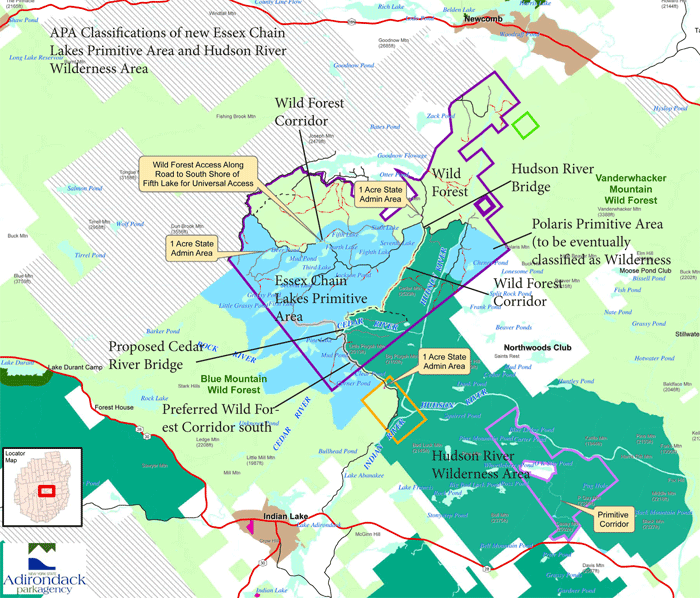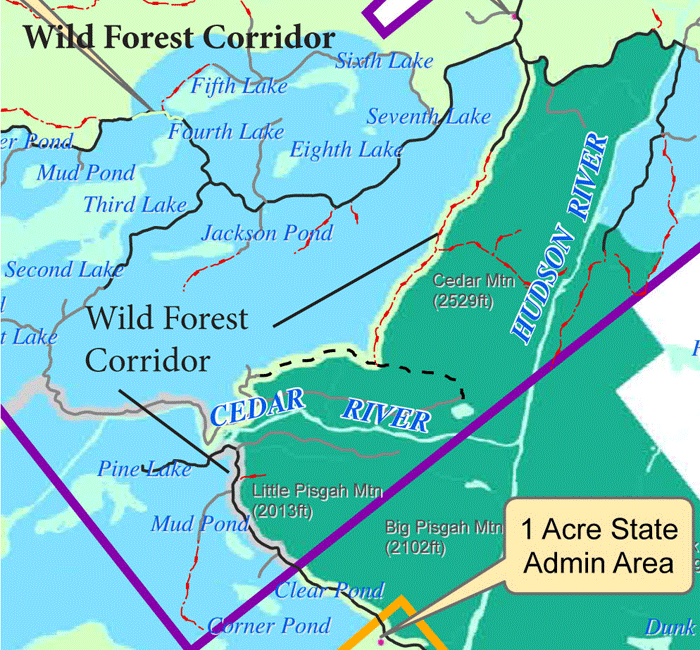PROTECT cheers a new 23,000 acre new Hudson Gorge Wilderness area and 9,940-Acre motorless Primitive area for Essex Chain Lakes
Decision sets troubling long-term precedents for motorized Wild Forest corridor through the heart of the new Forest Preserve lands and for construction and maintenance of permanent bridges over protected scenic rivers.
See PROTECT press release.
The Adirondack Park Agency (APA) and Department of Environmental Conservation (DEC) completed its approval of official classifications today for over 42,000 acres of Forest Preserve lands into Wilderness, Primitive and Wild Forest areas. This action involved classification of over 22,000 acres of new Forest Preserve lands and reclassification of over 20,000 acres of existing Forest Preserve lands.
The APA created a new 23,572-acre Hudson Gorge Wilderness Area and a 9,940-acre Essex Chain Lakes Primitive area and classified 7,377 acres as Wild Forest. Another 963-acre Polaris Primitive Area was also created, but is scheduled to be classified as Wilderness once all reserved leaseholder rights expire in 2019.
In 2012, Governor Cuomo announced that the state would purchase 69,000 acres of new Forest Preserve lands from The Nature Conservancy. The first three tracts, purchased in 2012 and 2013, were included in the APA’s action today. These total 21,000 acres: the 18,230-acre Essex Chain Tract, 2,823-acre OK Slip Falls Tract, and 923-acre Indian River Tract. The APA also reclassified roughly 20,000 acres of existing Forest Preserve lands, including the 17,000-acre Hudson Gorge Primitive area.
The creation of a new Hudson Gorge Wilderness Area is a historic accomplishment. This protects over 15 miles of the Hudson River as Wilderness, a great tribute to New York’s grandest river. PROTECT congratulate the APA and DEC on the creation of the new Hudson River Wilderness Area.
Protect the Adirondacks called for the creation of a 39,000-acre Wilderness Area for these lands. In the end, APA action protected over 34,000 acres as “motorless” core areas under Primitive or Wilderness designations. Public comments from the APA’s public hearings in the summer of 2013 ran 4 – 1 in support of a new Wilderness Area for the Essex Chain Lakes.
The decision to classify the Essex Chain Lakes as Primitive largely keeps this area motorless, except for float plane use on First Lake. A Primitive classification will provide strong natural resource protection for this sensitive area and ensure a wild outdoor recreational experience for the public.
The classification package also included the creation of a motorized Wild Forest corridor through the heart of this area. The motorized Wild Forest corridor sets a dangerous precedent for Forest Preserve management whereby lines will be drawn solely to facilitate motor vehicle uses in the forever wild Forest Preserve.
The APA’s action also determined to retain a temporary bridge over the Hudson River and recommends construction of a new bridge over the Cedar River. These actions will necessitate changes to existing laws and state regulations that govern designated rivers under the Wild, Scenic and Recreational Rivers Act as well as Forest Preserve management laws and regulations.
This Classification Creates Long-Term Challenges
The APA’s decision is contingent to subsequent actions by the APA and Department of Environmental Conservation to revise existing state laws or regulations. These include:
1. The APA emphasized a preference for the Wild Forest corridor to extend across the Cedar River. This action will necessitate a revision to DEC regulations for management of Wild, Scenic and Recreational Rivers for bridge construction and motor vehicle use in a Scenic River corridor.
2. The APA emphasized a preference for the Wild Forest corridor to extend across the Cedar River. This action will necessitates a revision in the State Land Master Plan for elimination of the current requirement for natural materials in bridge construction.
3. The APA also pledges to review State Land Master Plan revisions to allow mountain biking in Primitive Areas.
4. The APA also pledged to work with the DEC to revise the Wild, Scenic and Recreational Rivers Act to allow motor vehicle use within a Wild Forest corridor.
Protect the Adirondacks will continue to monitor the APA’s and DEC’s plans around bridge retention and construction. These are controversial issues and need extensive public scrutiny and intervention.
Review Process Marred by Numerous Irregularities
Protect the Adirondacks sought a legal and policy document that were instrumental in the APA’s classification decision, but the APA has withheld this document and refused to release it under the Freedom of Information Act. Unfortunately, the APA has withheld information from the public regarding classification and management of public lands. This makes no sense and was an unfortunate decision by the APA. PROTECT also questioned APA’s compliance with the State Environmental Quality Review Act.







